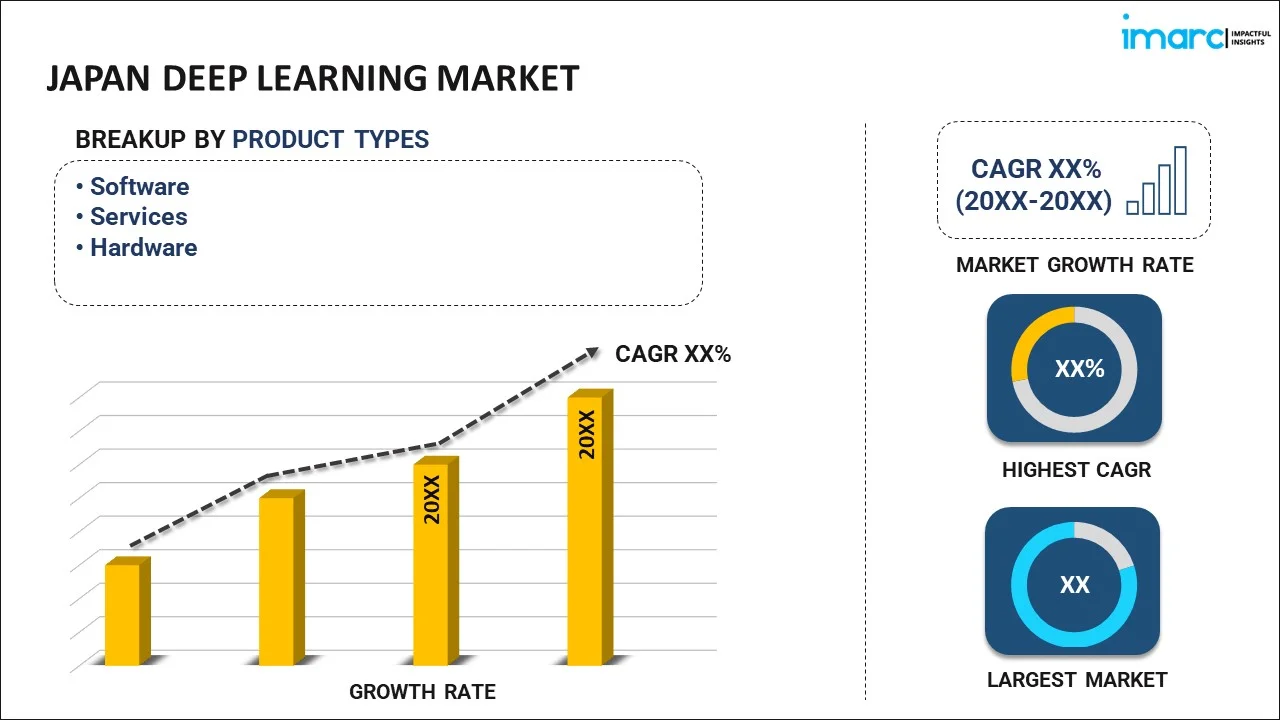
Japan Deep Learning Market Report by Product Type (Software, Services, Hardware), Application (Image Recognition, Signal Recognition, Data Mining, and Others), End Use Industry (Security, Manufacturing, Retail, Automotive, Healthcare, Agriculture, and Others), Architecture (RNN, CNN, DBN, DSN, GRU), and Region 2025-2033
Market Overview:
Japan deep learning market size reached USD 1,827.5 Million in 2024. Looking forward, IMARC Group expects the market to reach USD 29,986.0 Million by 2033, exhibiting a growth rate (CAGR) of 36.5% during 2025-2033. The increasing proliferation of digital data from various sources, including social media, IoT devices, and sensors, that provides a rich source of information for deep learning algorithms, is driving the market.
|
Report Attribute
|
Key Statistics
|
|---|---|
|
Base Year
|
2024
|
|
Forecast Years
|
2025-2033
|
|
Historical Years
|
2019-2024
|
| Market Size in 2024 | USD 1,827.5 Million |
| Market Forecast in 2033 | USD 29,986.0 Million |
| Market Growth Rate 2025-2033 | 36.5% |
Deep learning is a subset of artificial intelligence that mimics the human brain's neural networks to solve complex tasks. It involves training deep neural networks, which are composed of many interconnected layers of artificial neurons, to learn patterns and representations from data. These networks excel at tasks like image and speech recognition, natural language processing, and even autonomous decision-making. Deep learning's power lies in its ability to automatically discover and extract features from raw data, eliminating the need for manual feature engineering. It relies on large datasets and powerful computing hardware, particularly GPUs, to train models effectively. Popular deep learning architectures include convolutional neural networks (CNNs) for image analysis and recurrent neural networks (RNNs) for sequential data. The applications of deep learning are vast and include self-driving cars, medical diagnosis, recommendation systems, and more. Its continuous development and innovation have made it a transformative technology with the potential to revolutionize various industries by enabling machines to learn and make decisions like humans.
Japan Deep Learning Market Trends:
The deep learning market in Japan is propelled by a confluence of factors that have transformed the landscape of artificial intelligence (AI). Firstly, the exponential growth of data availability, coupled with the rise of big data analytics, has paved the way for deep learning algorithms to thrive. Moreover, the continuous advancement in computing power, driven by innovations in GPU technology and cloud computing, has made it feasible to train deep neural networks at an unprecedented scale and speed. Furthermore, the increased adoption of deep learning across industries such as healthcare, finance, and autonomous vehicles has led to a surge in demand for deep learning solutions. This burgeoning demand is not only fueled by the promise of improved decision-making and automation but also by the escalating need to extract meaningful insights from vast datasets. In sum, the deep learning market in Japan is expected to be driven by a synergy of data abundance, computational prowess, expanding application domains, and accessible tools, setting the stage for continued growth and innovation in the field.
Japan Deep Learning Market Segmentation:
IMARC Group provides an analysis of the key trends in each segment of the market, along with forecasts at the country level for 2025-2033. Our report has categorized the market based on product type, application, end use industry, and architecture.
Product Type Insights:

- Software
- Services
- Hardware
The report has provided a detailed breakup and analysis of the market based on the product type. This includes software, services, and hardware.
Application Insights:
- Image Recognition
- Signal Recognition
- Data Mining
- Others
A detailed breakup and analysis of the market based on the application have also been provided in the report. This includes image recognition, signal recognition, data mining, and others.
End Use Industry Insights:
- Security
- Manufacturing
- Retail
- Automotive
- Healthcare
- Agriculture
- Others
The report has provided a detailed breakup and analysis of the market based on the end use industry. This includes security, manufacturing, retail, automotive, healthcare, agriculture, and others.
Architecture Insights:
- RNN
- CNN
- DBN
- DSN
- GRU
A detailed breakup and analysis of the market based on the architecture have also been provided in the report. This includes RNN, CNN, DBN, DSN, and GRU.
Regional Insights:

- Kanto Region
- Kansai/Kinki Region
- Central/ Chubu Region
- Kyushu-Okinawa Region
- Tohoku Region
- Chugoku Region
- Hokkaido Region
- Shikoku Region
The report has also provided a comprehensive analysis of all the major regional markets, which include Kanto Region, Kansai/Kinki Region, Central/Chubu Region, Kyushu-Okinawa Region, Tohoku Region, Chugoku Region, Hokkaido Region, and Shikoku Region.
Competitive Landscape:
The market research report has also provided a comprehensive analysis of the competitive landscape. Competitive analysis such as market structure, key player positioning, top winning strategies, competitive dashboard, and company evaluation quadrant has been covered in the report. Also, detailed profiles of all major companies have been provided.
Japan Deep Learning Market Report Coverage:
| Report Features | Details |
|---|---|
| Base Year of the Analysis | 2024 |
| Historical Period | 2019-2024 |
| Forecast Period | 2025-2033 |
| Units | Million USD |
| Scope of the Report | Exploration of Historical and Forecast Trends, Industry Catalysts and Challenges, Segment-Wise Historical and Predictive Market Assessment:
|
| Product Types Covered | Software, Services, Hardware |
| Applications Covered | Image Recognition, Signal Recognition, Data Mining, Others |
| End Use Industries Covered | Security, Manufacturing, Retail, Automotive, Healthcare, Agriculture, Others |
| Architectures Covered | RNN, CNN, DBN, DSN, GRU |
| Regions Covered | Kanto Region, Kansai/Kinki Region, Central/ Chubu Region, Kyushu-Okinawa Region, Tohoku Region, Chugoku Region, Hokkaido Region, Shikoku Region |
| Customization Scope | 10% Free Customization |
| Post-Sale Analyst Support | 10-12 Weeks |
| Delivery Format | PDF and Excel through Email (We can also provide the editable version of the report in PPT/Word format on special request) |
Key Questions Answered in This Report:
- How has the Japan deep learning market performed so far and how will it perform in the coming years?
- What has been the impact of COVID-19 on the Japan deep learning market?
- What is the breakup of the Japan deep learning market on the basis of product type?
- What is the breakup of the Japan deep learning market on the basis of application?
- What is the breakup of the Japan deep learning market on the basis of end use industry?
- What is the breakup of the Japan deep learning market on the basis of architecture?
- What are the various stages in the value chain of the Japan deep learning market?
- What are the key driving factors and challenges in the Japan deep learning?
- What is the structure of the Japan deep learning market and who are the key players?
- What is the degree of competition in the Japan deep learning market?
Key Benefits for Stakeholders:
- IMARC’s industry report offers a comprehensive quantitative analysis of various market segments, historical and current market trends, market forecasts, and dynamics of the Japan deep learning market from 2019-2033.
- The research report provides the latest information on the market drivers, challenges, and opportunities in the Japan deep learning market.
- Porter's five forces analysis assist stakeholders in assessing the impact of new entrants, competitive rivalry, supplier power, buyer power, and the threat of substitution. It helps stakeholders to analyze the level of competition within the Japan deep learning industry and its attractiveness.
- Competitive landscape allows stakeholders to understand their competitive environment and provides an insight into the current positions of key players in the market.
Need more help?
- Speak to our experienced analysts for insights on the current market scenarios.
- Include additional segments and countries to customize the report as per your requirement.
- Gain an unparalleled competitive advantage in your domain by understanding how to utilize the report and positively impacting your operations and revenue.
- For further assistance, please connect with our analysts.
 Inquire Before Buying
Inquire Before Buying
 Speak to an Analyst
Speak to an Analyst
 Request Brochure
Request Brochure
 Request Customization
Request Customization




.webp)




.webp)












